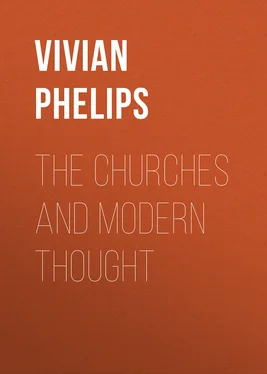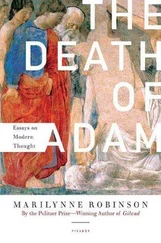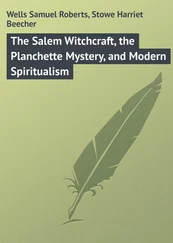Vivian Phelips - The Churches and Modern Thought
Здесь есть возможность читать онлайн «Vivian Phelips - The Churches and Modern Thought» — ознакомительный отрывок электронной книги совершенно бесплатно, а после прочтения отрывка купить полную версию. В некоторых случаях можно слушать аудио, скачать через торрент в формате fb2 и присутствует краткое содержание. Жанр: foreign_prose, foreign_religion, Философия, foreign_antique, на английском языке. Описание произведения, (предисловие) а так же отзывы посетителей доступны на портале библиотеки ЛибКат.
- Название:The Churches and Modern Thought
- Автор:
- Жанр:
- Год:неизвестен
- ISBN:нет данных
- Рейтинг книги:4 / 5. Голосов: 1
-
Избранное:Добавить в избранное
- Отзывы:
-
Ваша оценка:
- 80
- 1
- 2
- 3
- 4
- 5
The Churches and Modern Thought: краткое содержание, описание и аннотация
Предлагаем к чтению аннотацию, описание, краткое содержание или предисловие (зависит от того, что написал сам автор книги «The Churches and Modern Thought»). Если вы не нашли необходимую информацию о книге — напишите в комментариях, мы постараемся отыскать её.
The Churches and Modern Thought — читать онлайн ознакомительный отрывок
Ниже представлен текст книги, разбитый по страницам. Система сохранения места последней прочитанной страницы, позволяет с удобством читать онлайн бесплатно книгу «The Churches and Modern Thought», без необходимости каждый раз заново искать на чём Вы остановились. Поставьте закладку, и сможете в любой момент перейти на страницу, на которой закончили чтение.
Интервал:
Закладка:
One of the first suspicions that ever crossed my mind was with regard to the sudden and complete disappearance of the “two tables of testimony, tables of stone written with the finger of God.” 54 54 Exodus xxxi. 18 and xxxii. 16. Or, to be precise, these having been broken and their fragments considered of no value at the time, the duplicates carefully prepared and inscribed to the dictation of God Himself (Exodus xxxix.).
Later on, when I knew of the Moabite stone 55 55 Believed to date from about 853 B.C. The inscription records the victories of King Mesha over the Israelites.
and the Rosetta stone, 56 56 Erected in honour of Ptolemy Epiphanes, 106 B.C. Famous as having furnished the first key for the interpretation of Egyptian hieroglyphics.
and especially when I learnt that there were inscriptions on bricks and cylinders of a far earlier date than that ascribed to the giving of the Ten Commandments, the old perplexity returned with added force. I remember, too, the same feeling of dissatisfaction and suspicion as I gazed on the clearly-cut Pali inscriptions in the Buddhist caves near Poona, and thought of those lost tables said to have been inscribed by the finger of God. I once put the question to a well-read clerical friend of mine: “How can these tables, written by the finger of God or by His direct inspiration, have been lost? How is it that they have simply disappeared without a word of explanatory comment in the Bible? It is inconceivably strange. What a witness would they not have been to the truth of the Old Testament account, and to the Divine authority for the Commandments!” His reply was: “It would never have done for these stones to have been preserved, for they would have become objects of worship.” Granted that they might have become objects of adoration, which is worse—to worship faked relics such as the water in which Joseph of Arimathea washed the blood-stained body of Jesus, portions of wood from the true Cross, bits from the crown of thorns, and thousands of odd pieces of bone from the anatomy of the Saints; or to venerate stones that would at least have had the merit of being genuine? Why are we left without any reliable evidences of God’s miraculous revelation of Himself to men, while we have abundant evidence for occurrences of trifling importance to mankind that happened thousands of years before the alleged revelation? Hammurabi (a Babylonian monarch who flourished two thousand years or more before the Christian era) inscribed a very excellent, if somewhat drastic, code of laws upon a pillar of black diorite, and we have now got the stone and read the inscriptions; but the stone inscribed by God is lost!
The Book of Deuteronomy. —Evidence of every kind concurs to prove that in its original form it was a product of the seventh, not of the fifteenth, century B.C. In its present form, Deuteronomy is a composite and considerably modified version of the older work. Originally it may have consisted merely of the long speech attributed to Moses, and this may have been the book which was “found” in the temple in the reign of Josiah, the rest of the work being added shortly afterwards.
As it is difficult to believe that such a work would have remained in the temple undiscovered for eight hundred years, is it not reasonable to conclude that the book was placed there by men who thought the time ripe for religious reforms—in fact, that a “pious fraud” was perpetrated?
The Psalms a Composite Book. —The fond delusion that all the Psalms were written by David (though why we should be anxious to ascribe what is really of much ethical value to a person confessedly immoral I never could understand) has been entirely dispelled. It is doubtful whether David wrote any of the Psalms.
Poetry and Prophetic Literature. —The book of Job is not a literary unity, nor was it written with any particular purpose; it is not a manufacture, but a growth.
Jonah is a Jewish midrash , or tradition, like the histories of Tobit and Susanna, and was certainly written after the Exile. Even orthodox clergymen now admit (in private) that the Jonah story is a fairy tale.
The great book of Isaiah is the work of several authors.
The book of Daniel was once assumed to be the most definitely prophetical of the Old Testament writings—a notion which is seriously discounted by the discovery that it was beyond question written in the time of Antiochus Epiphanes, after or during the happening of the events which were supposed to be foretold, and nearly 500 years after the time of its supposed author. It is questionable whether such a person as Daniel ever existed; but it is certain that his adventure in the den of lions, and that of Shadrach, Meshach, and Abed-nego in the fiery furnace, are as fabulous as any in the collection of Æsop.
“As a rule,” says Canon Cheyne, “the prophets directly connect the final restoration with the removal of the sins of their own age, and with the accomplishment of such a work of judgment as lies within their own horizon; to Isaiah the last troubles are those of the Assyrian invasion; to Jeremiah the restoration follows on the exile to Babylon; Daniel connects the future glory with the overthrow of the Greek monarchy.” 57 57 Encyclopædia Biblica , art. “Messiah,” p. 3058, par. 2.
Referring to non-Christian parallels to the belief in a Messiah, Canon Cheyne draws special attention to a Babylonian parallel, and concludes that “it is historically very conceivable that a Babylonian belief may be the real parent both of this and of all other Messianic beliefs within the sphere of Babylonian influence.” 58 58 Ibid , p. 3063, par 10.
The manner in which these so-called prophets can be looked upon as foretelling is explained elsewhere 59 59 In Studies in the Character of Christ , by Rev. C. H. Robinson, Hon. Canon of Ripon and Editorial Secretary to the S.P.G.
as follows: “The prophets in the Old Testament, being inspired to interpret human needs, became unconscious prophets of the Christ.... It is quite true that prophecy explained in this way is no longer available for the truth of Christianity to the same extent that it once was—at any rate, for the convincing of unbelievers.”
New Testament Chronology. —We do not know exactly when or where 60 60 Enc. Bib. , art. “Nativity,” par. 10, 11, 12.
Jesus was born, when He died, or how long He ministered. As to the birth of Jesus, the only account which claims to give indications of date rests on a series of mistakes. No census was possible under Herod, and none took place under “Cyrenius” until A.D. 7. The only results which have a high degree of probability are the date A.D. 30 for the death of Jesus, and the period of about one year—conservative opinion estimates it to be three years—for the length of His public ministry.
The Virgin Birth. —The Gospels themselves afford the amplest justification for a criticism of their narratives. Jesus Himself made no appeal to His supposed miraculous birth. The only two verses in the first chapter of St. Luke which clearly express the idea of a supernatural birth so disturb the connection that we are impelled to regard them as an interpolation. It is Joseph, and not Mary, whose descent is traced from the son of Jesse. The genealogy of Joseph, given in the first Gospel, is prior in date to the story of the Virgin Birth, and could have been drawn up only while he was regarded as the real father of Jesus. Also St. Paul’s statement that Jesus was born of the seed of David according to the flesh cannot be reconciled with the account of his having been born of a virgin. There is no recorded adoration of the Virgin by St. Paul, or, for the matter of that, by any of the Apostles or disciples.
Читать дальшеИнтервал:
Закладка:
Похожие книги на «The Churches and Modern Thought»
Представляем Вашему вниманию похожие книги на «The Churches and Modern Thought» списком для выбора. Мы отобрали схожую по названию и смыслу литературу в надежде предоставить читателям больше вариантов отыскать новые, интересные, ещё непрочитанные произведения.
Обсуждение, отзывы о книге «The Churches and Modern Thought» и просто собственные мнения читателей. Оставьте ваши комментарии, напишите, что Вы думаете о произведении, его смысле или главных героях. Укажите что конкретно понравилось, а что нет, и почему Вы так считаете.












